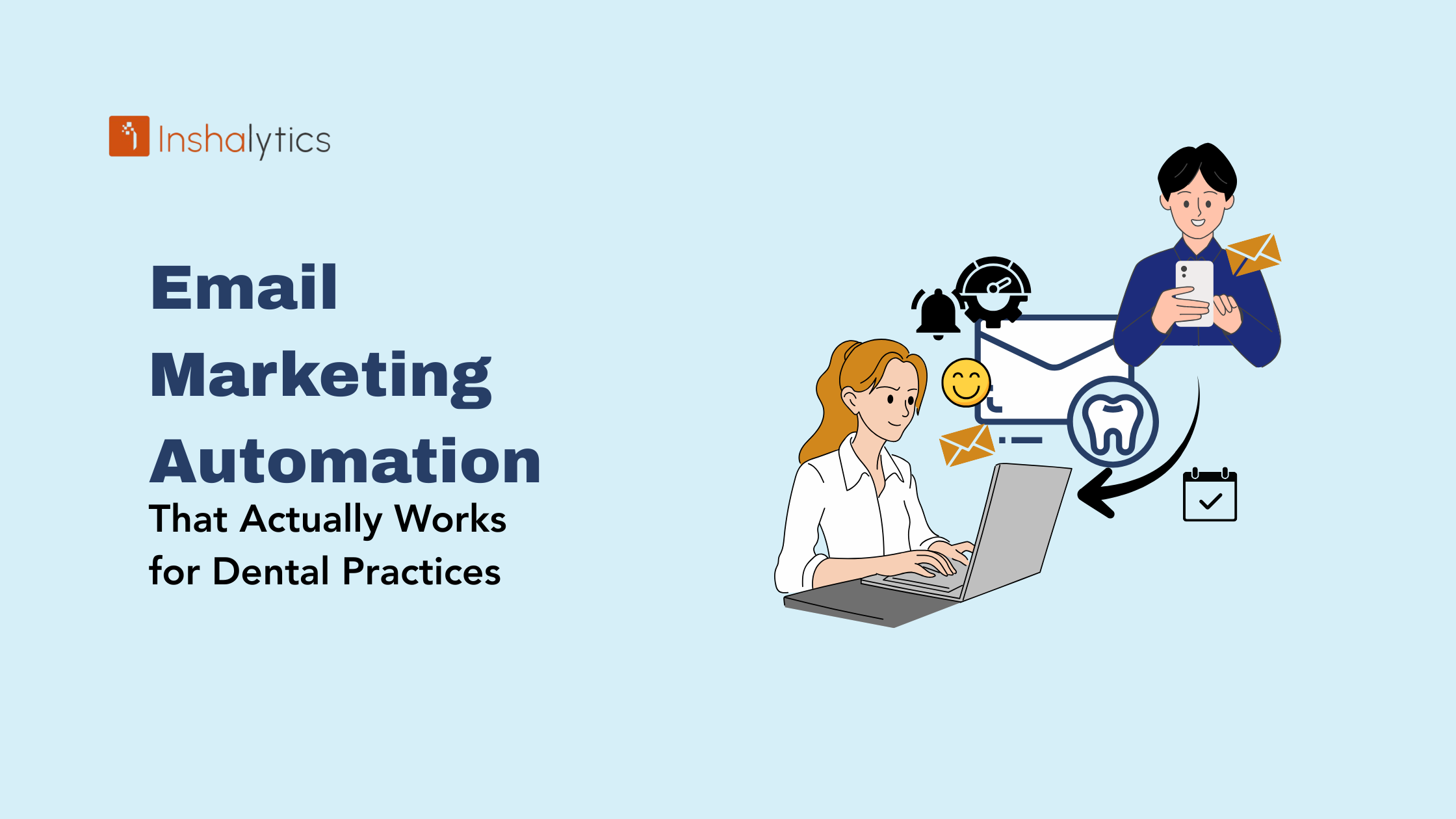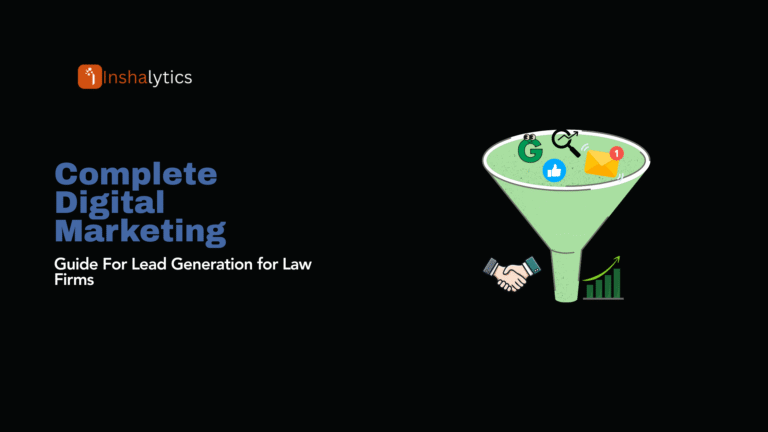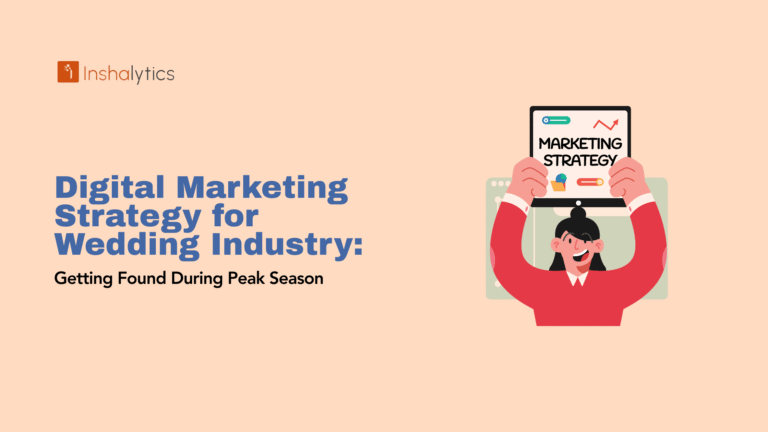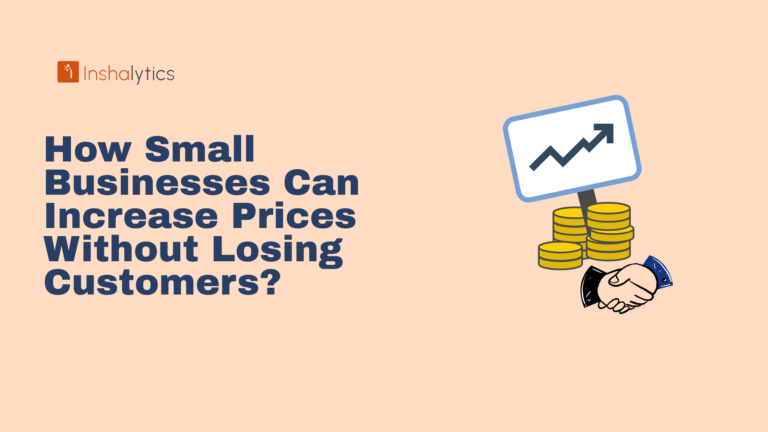Email marketing automation has revolutionized how dental practices build patient relationships and grow their businesses, delivering an average ROI of $36 for every dollar spent. For dental practices competing in crowded markets while managing complex patient care schedules, automation provides the perfect solution for consistent, personalized patient communication without overwhelming already busy dental teams.
Unlike generic promotional emails that patients immediately delete, dental email marketing automation creates intelligent workflows that respond to patient behaviors, appointment history, and treatment needs. This targeted approach, combined with dental lead follow up automation, transforms occasional patients into loyal, long-term practice advocates while significantly reducing the administrative burden on front office staff.
Modern dental practices that implement strategic email automation see 40% increases in appointment bookings, 60% improvements in treatment acceptance rates, and 80% reductions in no-shows—all while building stronger patient relationships that drive referrals and practice growth.
What Is Dental Email Marketing Automation?
Dentist local marketing automation uses specialized software to send targeted emails based on specific triggers, patient behaviors, or predefined schedules related to dental care cycles. Instead of manually reminding patients about appointments or follow-up care, practices create automated workflows that deliver the right dental health message to the right patient at precisely the right moment.
The Critical Difference for Dental Practices:
Unlike other businesses that focus primarily on sales, dental practices must balance patient education, appointment management, treatment reminders, and relationship building. Email automation addresses these unique challenges by:
- Reducing No-Show Rates: Automated appointment reminders decrease missed appointments by up to 38%
- Improving Treatment Acceptance: Strategic follow-up sequences increase case acceptance by 25-40%
- Enhancing Preventive Care: Automated recall systems boost hygiene appointment compliance by 45%
- Building Patient Trust: Consistent, valuable communication establishes practices as trusted healthcare partners
- Streamlining Operations: Reduces front desk administrative tasks by 60%, allowing staff to focus on patient care
The Dental Industry Impact:
Dental marketing automation see 451% more qualified new patient inquiries and experience 80% increases in patient retention rates. For practices operating with limited marketing budgets and busy clinical schedules, these improvements directly impact profitability and growth.
Modern dental email automation integrates seamlessly with comprehensive dental marketing strategies, amplifying the effectiveness of local SEO efforts, social media patient testimonials, and reputation management initiatives.
5 Types of Email Automation Every Dental Practice Should Use
New patient welcome emails generate 320% more engagement than standard promotional campaigns, making them essential for establishing lasting patient relationships. A strategic welcome series introduces new patients to your practice while setting clear expectations for their dental care journey.
Essential New Patient Welcome Components:
- Immediate Welcome: Confirm appointment and provide new patient forms and preparation instructions
- Practice Introduction: Share your dental philosophy, team credentials, and commitment to patient comfort
- Office Tour and Technology: Highlight state-of-the-art equipment and patient-focused amenities
- Patient Success Stories: Feature testimonials and before/after cases (with proper consent)
- Insurance and Payment Options: Clearly explain financial policies and available payment plans
Trust-Building Elements:
- Doctor and hygienist credentials and continuing education
- Advanced technology explanations (digital X-rays, laser therapy, etc.)
- Infection control and safety protocols
- Emergency contact information and after-hours procedures
Appointment Reminder and Confirmation Campaigns
With dental appointment no-show rates averaging 15-20%, automated reminder campaigns represent immediate revenue protection opportunities. These workflows ensure patients remember appointments while providing opportunities for rescheduling when conflicts arise.
High-Impact Reminder Sequence:
- Initial Confirmation (48-72 hours prior): Appointment details with preparation instructions and cancellation policy
- Final Reminder (24 hours prior): Confirm attendance with easy rescheduling options and office contact information
- Day-Of Text Integration: Brief reminder with parking information and arrival time expectations
Enhanced Reminder Features:
- Pre-Appointment Instructions: Specific guidance for different procedure types
- Insurance Verification: Reminders to bring current insurance cards and identification
- Medical History Updates: Requests to update medications and health conditions
- Comfort Measures: Information about sedation options and anxiety management
Treatment Follow-Up and Care Instructions
Post-treatment communication demonstrates genuine care for patient well-being while reducing emergency calls and complications. These sequences provide detailed care instructions and monitor patient recovery progress.
Comprehensive Follow-Up Timeline:
- Immediate Post-Treatment: Detailed care instructions and emergency contact information
- 24-Hour Check-In: Recovery progress assessment with option for questions or concerns
- One Week Follow-Up: Healing evaluation and appointment scheduling for next treatment phases
- Treatment Completion: Final results celebration and maintenance care recommendations
Treatment-Specific Sequences:
- Surgical Procedures: Detailed recovery protocols and warning signs to monitor
- Restorative Work: Care instructions for crowns, fillings, and other restorations
- Orthodontic Treatment: Progress monitoring and compliance encouragement
- Cosmetic Procedures: Results, care, and maintenance for optimal longevity
Hygiene Recall and Preventive Care Campaigns
Preventive care appointments represent the foundation of dental practice profitability and patient health. Automated recall campaigns ensure patients maintain regular hygiene visits while identifying opportunities for additional treatments.
Strategic Recall Campaign Elements:
- Early Reminders (6 weeks before due): Gentle notification with convenient scheduling options
- Direct Scheduling (4 weeks before): Easy online booking with preferred hygienist selection
- Final Notice (2 weeks before): Urgent reminder with health consequences of delayed care
- Overdue Follow-Up: Re-engagement attempt with flexible scheduling and payment options
Value-Added Recall Features:
- Seasonal Oral Health Tips: Timely advice for holiday eating, sports protection, etc.
- Technology Updates: Information about new treatments and diagnostic capabilities
- Family Scheduling: Convenient options for multiple family member appointments
- Preventive Product Recommendations: Suggestions for home care improvements
Patient Reactivation and Win-Back Sequences
Inactive patients represent significant missed revenue opportunities and potential oral health risks. Reactivation campaigns identify lapsed patients and provide compelling reasons to return while addressing potential concerns about extended absence.
Effective Reactivation Strategy:
- Gentle Re-Engagement: Caring message expressing concern for the patient’s well-being
- Value Proposition Reminder: Highlight practice improvements and new services
- Barrier Removal: Address common concerns about cost, time, or dental anxiety
- Special Incentives: Limited-time offers for comprehensive exams or specific treatments
- Final Outreach: Last attempt before removing from active patient database
Reactivation Personalization:
- Reference specific treatments or concerns from last visit
- Acknowledge time since last appointment without judgment
- Highlight relevant new services based on patient history
- Provide flexible scheduling options for returning patients
How to Set Up Dental Email Marketing Automation?
Selecting the right platform requires understanding both general email marketing capabilities and dental-specific compliance requirements. Dental practices need solutions that integrate with practice management software while maintaining HIPAA compliance.
Essential Dental Platform Features:
- HIPAA Compliance: Encrypted data transmission and secure patient information handling
- Practice Management Integration: Seamless connection with dental software systems
- Patient Segmentation: Ability to group patients by treatment history, appointment patterns, and demographics
- Automated Scheduling Links: Integration with online appointment booking systems
- Compliance Templates: Pre-designed emails that meet healthcare communication standards
Popular Dental-Focused Options:
- RevenueWell: Comprehensive dental marketing automation with practice management integration
- Lighthouse 360: Patient communication platform designed specifically for dental practices
- Dental Intelligence: Analytics-driven patient communication and marketing automation
- NexHealth: Patient experience platform with email automation and scheduling integration
HIPAA Compliance Considerations:
- Business Associate Agreements (BAAs) with email platform providers
- Encrypted email transmission and storage protocols
- Patient consent for marketing communications
- Opt-out mechanisms that comply with healthcare regulations
- Audit trails for patient communication tracking
When evaluating platforms, consider how email automation fits within your broader dental marketing ecosystem and choose solutions that integrate seamlessly with existing practice management and patient communication tools.
Set Up Your First Dental Automation Workflow
Start with high-impact, low-complexity automations that deliver immediate results while your team learns the system and patients adjust to improved communication.
Beginner-Friendly First Workflow: Appointment Confirmation
Step 1: Define Your Dental-Specific Trigger: Choose a specific patient action that initiates the sequence:
- New patient appointment booking
- Treatment plan acceptance
- Hygiene appointment scheduling
- Emergency appointment request
Step 2: Map Your Patient Care Journey: Understand what patients need at each dental care stage:
- Pre-Appointment: Preparation instructions and anxiety management
- Confirmation: Clear appointment details and practice policies
- Pre-Treatment: Specific procedure preparation and expectations
- Post-Treatment: Care instructions and follow-up scheduling
Step 3: Create Patient-Focused Email Sequence: Develop 2-4 emails that guide patients toward optimal dental health:
- Clear, reassuring subject lines that reduce dental anxiety
- Educational content that builds trust and treatment acceptance
- Consistent branding that reinforces practice professionalism
- Specific calls-to-action for appointment confirmation or rescheduling
Step 4: Set Appropriate Timing and Conditions: Establish when emails are sent based on dental care timelines:
- Immediate confirmation for new appointments
- 48-72 hour pre-appointment preparation reminders
- 24-hour final confirmation with arrival instructions
- Logic conditions based on treatment type and patient history
Create HIPAA-Compliant Email Templates and Content
Consistent, professional email design builds patient confidence while streamlined content creation processes save valuable staff time and ensure compliance with healthcare communication standards.
Dental Template Design Essentials:
- Professional Medical Aesthetic: Clean, trustworthy design that reflects healthcare standards
- Mobile Optimization: 60% of patients check email on mobile devices
- Clear Contact Information: Prominent display of practice phone and emergency numbers
- Brand Consistency: Include practice logos, colors, and fonts that match website and office materials
HIPAA-Compliant Content Framework:
- Subject Line: Professional and informative without revealing specific treatment details
- Personal Greeting: Use patient names appropriately while maintaining privacy
- Educational Value: Provide oral health information and procedure explanations
- Clear Instructions: Specific guidance for appointments, treatments, or home care
- Professional Closing: Include provider credentials and practice contact information
Dental Automation Content Guidelines:
- Avoid specific treatment details in subject lines or preview text
- Use encouraging, anxiety-reducing language throughout
- Reference general oral health rather than individual patient conditions
- Include disclaimers for medical advice and emergency situations
- Provide clear opt-out options for marketing communications
Test and Optimize Your Dental Campaigns
Continuous testing and optimization ensure dental automation campaigns build patient relationships effectively while maximizing appointment bookings and treatment acceptance.
Essential Dental Testing Elements:
- Subject Lines: Compare anxiety-reducing versus informational approaches
- Send Times: Identify when dental patients most actively check email
- Content Formats: Test educational versus procedural instruction emails
- CTA Effectiveness: Experiment with appointment booking versus phone call prompts
- Personalization Levels: Find an optimal balance between personal and professional communication
Dental-Specific Optimization Metrics:
- Appointment confirmation rates and no-show reduction
- Treatment plan acceptance increases
- Hygiene recall appointment compliance
- Emergency call reduction after treatment
- Patient satisfaction scores related to communication
Advanced dental email automation optimization often benefits from a comprehensive dental marketing analysis to understand how email performance connects with overall practice growth objectives and patient satisfaction metrics.
Best Email Marketing Automation Tools for Dental Practices
Different email automation platforms serve dental practices with varying needs, making platform selection crucial for long-term patient communication success and practice growth.
Dental Evaluation Criteria:
- HIPAA Compliance: Does the platform provide necessary healthcare data protection?
- Practice Management Integration: How well does it connect with existing dental software?
- Dental Template Library: Are pre-built dental communications available?
- Patient Segmentation: Can it group patients by treatment history and care needs?
- Appointment Integration: Does it sync with dental scheduling systems?
- Compliance Support: Are healthcare communication regulations addressed?
Top Dental Platform Recommendations
For New Practices: RevenueWell
- Comprehensive dental marketing automation suite
- Strong practice management software integration
- Pre-built dental email templates and campaigns
- HIPAA-compliant patient communication features
- Excellent onboarding and training support
for Established Practices: Lighthouse 360
- Advanced patient communication workflows
- Robust analytics and reporting dashboards
- Multi-channel communication, including email, text, and phone
- Strong reputation management integration
- Comprehensive patient reactivation tools
For Tech-Forward Practices: Dental Intelligence
- AI-powered patient communication optimization
- Advanced analytics and predictive modeling
- Seamless integration with modern practice management systems
- Automated treatment plan follow-up sequences
- Performance benchmarking against similar practices
For Patient Experience Focus: NexHealth
- Comprehensive patient experience platform
- Easy online scheduling integration
- Patient portal communication features
- Review and reputation management tools
- Insurance verification and payment processing integration
HIPAA Compliance and Integration Considerations
Dental email automation must comply with healthcare regulations while integrating seamlessly with existing practice management systems and patient communication workflows.
Critical Compliance Requirements:
- Business Associate Agreements: Formal HIPAA compliance documentation with platform providers
- Data Encryption: Secure transmission and storage of patient information
- Patient Consent: Clear opt-in processes for marketing communications
- Audit Trails: Complete documentation of patient communication history
- Access Controls: Restricted platform access based on staff roles and responsibilities
Integration Best Practices:
- Practice Management Sync: Real-time patient data updates and appointment scheduling
- Patient Portal Connection: Unified communication across all patient touchpoints
- Insurance Verification: Automated eligibility checks and benefit explanations
- Reputation Management: Coordinated review requests and online presence management
A professional dental marketing consultation can help practices select and integrate platforms that work together effectively while maintaining strict healthcare compliance standards.
Email Automation Best Practices That Drive Dental Practice Results
Generic dental emails achieve poor results while targeted, personalized messages generate significantly higher patient engagement and treatment acceptance rates.
High-Impact Dental Segmentation Methods:
- Treatment History Segmentation: Group patients by completed procedures and future needs
- Appointment Behavior Segmentation: Regular patients, overdue patients, and no-show patterns
- Age-Based Segmentation: Pediatric, adult, and senior-specific oral health messaging
- Insurance Status Segmentation: Different messaging for various insurance plans and payment methods
- Anxiety Level Segmentation: Customized communication for anxious versus confident patients
Dental Personalization Beyond Names:
- Reference specific treatments and progress in patient care journeys
- Recommend services based on treatment history and age-appropriate needs
- Customize appointment reminders based on procedure types and preparation requirements
- Adjust messaging tone for pediatric versus adult patient communications
Dynamic Dental Content Implementation:
- Show different preventive care recommendations based on patient age and risk factors
- Display location-specific information for multiple practice locations
- Customize appointment availability based on preferred providers and treatment types
- Personalize education content based on current treatments and oral health goals
Timing and Frequency Optimization for Dental Communications
Strategic timing maximizes patient engagement while respecting the unique rhythms of dental care cycles and patient communication preferences.
Dental Send Time Optimization:
- Appointment Reminders: Tuesday-Thursday, 10 AM – 2 PM typically achieve the highest confirmation rates
- Educational Content: Evening hours when patients have time to read health information
- Emergency Communications: Immediate send regardless of optimal timing considerations
- Recall Reminders: Monday mornings, when patients plan their upcoming weeks
Dental Communication Frequency Balance:
- Active Treatment Patients: More frequent communication during treatment phases
- Maintenance Patients: Quarterly educational content plus recall reminders
- Inactive Patients: Limited reactivation attempts to avoid perception as spam
- Emergency Patients: Immediate and follow-up communications as medically necessary
Dental Automation Spacing Considerations:
- Allow 48-72 hours between appointment-related communications
- Space educational content weekly to avoid overwhelming patients
- Consider seasonal factors affecting dental health (holidays, school schedules, insurance benefits)
- Pause non-essential automations during practice closures and holidays
Content Quality and Patient Education Focus
Dental patients expect valuable, trustworthy health information that helps them make informed decisions about their oral health and treatment options.
Value-First Dental Content Strategy:
- Educational Content: Oral health tips, procedure explanations, and preventive care guidance
- Treatment Spotlights: Detailed explanations of services with patient success stories
- Seasonal Health Tips: Holiday eating advice, sports mouth guard reminders, and school-year preparation
- Technology Updates: Information about new equipment and treatment options available at the practice
Dental Content Formatting Best Practices:
- Use clear, patient-friendly language that avoids excessive dental terminology
- Include visual elements like procedure illustrations and before/after photos (with consent)
- Write reassuring subject lines that reduce dental anxiety and build trust
- Maintain a professional, caring tone that reflects practice values and a patient-centered approach
Treatment-Focused Call-to-Action Optimization:
- Use encouraging language that emphasizes health benefits over commercial aspects
- Provide multiple contact options, including online scheduling, phone calls, and patient portal access
- Make appointment booking prominent with easy-to-use scheduling links
- Include emergency contact information for urgent dental needs
Effective dental email automation content supports broader dental marketing objectives, driving website traffic that contributes to local SEO performance and new patient acquisition.
Common Dental Email Automation Mistakes
Dental practices face unique regulatory requirements that can result in significant penalties when email automation systems inadvertently violate patient privacy protections.
Common HIPAA Violation Risks:
- Including specific treatment details in email subject lines visible to others
- Sending appointment reminders to incorrect email addresses
- Using non-encrypted email platforms for patient communication
- Failing to obtain proper consent for marketing communications
- Sharing patient information between family members without authorization
Prevention Strategies:
- Platform Vetting: Ensure all email automation platforms provide Business Associate Agreements
- Staff Training: Regular education on HIPAA requirements for digital patient communication
- Content Review: Establish approval processes for automated email templates and sequences
- Patient Consent: Clear opt-in processes that explain communication types and frequency
- Regular Audits: Periodic reviews of automation workflows and compliance procedures
Patient Privacy Protection:
- Use general appointment reminders without specific procedure details
- Implement double opt-in processes for marketing communications
- Provide easy opt-out options that immediately stop all non-essential communications
- Maintain audit trails for all patient email interactions
- Regular review of patient email addresses and communication preferences
Inappropriate Timing and Insensitive Messaging
Poorly timed or insensitive automated messages can damage patient relationships and practice reputation, particularly given the anxiety many patients associate with dental care.
Common Dental Timing Mistakes:
- Sending promotional emails immediately after emergency treatment
- Birthday emails that arrive during known difficult financial periods
- Recall reminders sent before insurance benefits renew
- Treatment follow-up emails that don’t account for recovery timelines
Insensitive Message Issues:
- Generic promotional content for patients dealing with complex oral health issues
- Aggressive payment reminders without considering individual patient circumstances
- Treatment recommendations that ignore patient-expressed financial constraints
- Appointment reminders that don’t acknowledge patient-reported anxiety
Solution Framework:
- Patient Journey Mapping: Understand emotional and physical states at different treatment phases
- Contextual Messaging: Tailor communication based on recent appointment history and treatment outcomes
- Empathy Integration: Train staff to review automated messages from patient’s perspective
- Flexible Scheduling: Provide multiple options for patients to respond to different situations
Neglecting Mobile Optimization for Dental Communications
With mobile devices accounting for 60% of healthcare-related email opens, mobile optimization directly impacts patient communication effectiveness and appointment confirmations.
Dental Mobile Optimization Essentials:
- Responsive Design: Templates that display properly on smartphones and tablets
- Touch-Friendly Elements: Easy-to-tap appointment confirmation and scheduling buttons
- Concise Subject Lines: Clear appointment information visible in mobile preview
- Single-Column Layouts: Ensure appointment details and instructions flow naturally on small screens
- Fast-Loading Content: Optimize images and content for quick mobile access
Dental-Specific Mobile Considerations:
- Emergency Contact Information: Prominently displayed practice phone numbers
- Appointment Details: Clear date, time, and location information easily visible
- Preparation Instructions: Mobile-friendly formatting for pre-appointment requirements
- Map Integration: Easy access to practice location and parking information
Ignoring Patient Feedback and Communication Preferences
Dental practices often focus on operational efficiency while overlooking patient communication preferences, leading to decreased engagement and potential patient loss.
Critical Patient Feedback Areas:
- Communication Frequency: How often patients want to receive different types of emails
- Content Preferences: Educational versus promotional versus appointment-focused messaging
- Timing Preferences: When patients prefer to receive dental communications
- Channel Preferences: Email versus text versus phone call preferences for different situations
Feedback Collection Methods:
- Post-Appointment Surveys: Include questions about communication preferences and satisfaction
- Email Preference Centers: Allow patients to customize frequency and content types
- Annual Communication Reviews: Systematic evaluation of patient communication satisfaction
- Staff Observations: Front desk insights about patient reactions to automated communications
Continuous Improvement Process:
- Regular Survey Distribution: Quarterly patient communication satisfaction assessments
- Data Analysis: Identify patterns in patient preferences and communication effectiveness
- System Adjustments: Modify automation workflows based on patient feedback
- Staff Training Updates: Ensure team understands and implements communication improvements
- Results Monitoring: Track improvements in patient satisfaction and engagement metrics
Advanced dental email automation often integrates with comprehensive dental practice marketing systems to understand email’s role in complete patient acquisition and retention strategies.
Measuring Dental Email Automation Success: Key Metrics and KPIs
Effective dental email automation measurement requires tracking metrics that directly connect to practice objectives rather than general marketing metrics that don’t reflect dental-specific success factors.
Primary Dental Success Metrics:
Open Rate Benchmarks:
- New patient welcome emails: 60-85% (significantly higher due to immediate relevance)
- Appointment reminder emails: 70-80%
- Hygiene recall campaigns: 45-55%
- Educational newsletters: 35-45%
- Treatment follow-up sequences: 65-75%
Click-Through Rate Targets:
- Appointment scheduling emails: 25-35%
- Treatment information sequences: 15-20%
- Preventive care reminders: 20-25%
- Practice update communications: 10-15%
Dental-Specific Conversion Goals:
- Appointment confirmation rates: 85-95%
- Hygiene recall booking: 60-70%
- Treatment plan acceptance: 40-50% improvement
- No-show rate reduction: 30-40% decrease
- Patient reactivation success: 15-25%
Appointment and Treatment-Focused ROI Calculation
Understanding dental email automation’s impact on practice productivity and revenue enables informed investment decisions and optimization prioritization.
Dental Revenue Tracking Methods:
- Appointment Value Calculation: Average revenue per appointment type multiplied by automation-generated bookings
- Treatment Acceptance Measurement: Increased case acceptance attributed to educational email sequences
- Preventive Care Revenue: Hygiene and maintenance appointments generated through recall campaigns
- Patient Lifetime Value: How automation affects long-term patient retention and comprehensive treatment acceptance
Dental ROI Calculation Framework:
Dental Email ROI = (Additional Appointments × Average Appointment Value – Platform Costs) / Platform Costs × 100
Comprehensive Dental Cost Considerations:
- Email platform subscription and setup fees
- Staff time for content creation and campaign management
- Integration costs with practice management software
- Ongoing optimization and compliance maintenance
- Patient acquisition cost comparison with other marketing channels
Advanced Dental Analytics and Patient Insights
Sophisticated dental email automation analytics provide insights that enable strategic practice management decisions beyond basic performance metrics.
Patient Behavior Analysis:
- Appointment Patterns: When and how patients respond to different types of scheduling communications
- Treatment Acceptance Journeys: Understanding paths from initial consultation to treatment completion
- Preventive Care Compliance: How automation affects regular hygiene appointment attendance
- Patient Lifecycle Management: Identifying patients at risk of becoming inactive
Practice Integration Analytics:
- Operational Efficiency: How email automation reduces front desk administrative tasks
- Patient Satisfaction Correlation: Email communication impact on overall practice reviews and ratings
- Staff Productivity Measurement: Time saved through automated patient communication
- Competitive Positioning: How communication quality affects patient retention versus competitor practices
Treatment-Specific Performance Analysis:
- Procedure Success Rates: Email education impact on treatment completion and patient satisfaction
- Emergency Reduction: How post-treatment communication affects urgent care calls
- Referral Generation: Patient communication influence on word-of-mouth marketing
- Insurance Optimization: How automated benefit reminders affect treatment timing and acceptance
Comprehensive dental email automation analytics often integrate with broader dental practice marketing measurement frameworks, providing holistic views of patient acquisition, retention, and lifetime value optimization.
Conclusion: Building Email Automation That Transforms Dental Practices
Email marketing automation represents one of the most effective and accessible digital marketing strategies specifically suited to dental practice needs. When implemented strategically, automation workflows create personalized patient experiences that build trust, improve oral health outcomes, and drive practice growth while reducing administrative burden on busy dental teams.
Success requires more than just selecting HIPAA-compliant platforms and creating automated appointment reminders. Dental practices must approach email automation as part of comprehensive dental marketing strategies that integrate seamlessly with local SEO efforts, online reputation management, patient review systems, and community outreach initiatives.
The dental practices that thrive with email automation treat it as patient relationship-building technology rather than just appointment scheduling tools. They focus on delivering consistent oral health value, respecting patient communication preferences, and continuously optimizing based on appointment data, treatment acceptance rates, and patient satisfaction feedback.
Key Success Factors for Dental Email Automation:
- HIPAA Compliance First: Never compromise patient privacy for marketing efficiency
- Patient Education Focus: Provide genuine oral health value in every communication
- Integration Priority: Ensure seamless workflow with practice management systems
- Staff Training Investment: Equip teams to manage and optimize automation systems effectively
- Continuous Optimization: Regular review and improvement based on practice-specific metrics
Ready to transform your dental practice with email marketing automation? Professional dental marketing guidance can help you implement these strategies effectively while maintaining strict healthcare compliance and avoiding common pitfalls that damage patient relationships. The investment in strategic automation setup pays dividends through improved patient retention, increased treatment acceptance, reduced no-shows, and sustainable practice growth.
Start with one simple automation workflow like appointment confirmations, measure its impact on your practice metrics carefully, and build complexity gradually as your team gains experience and patient satisfaction increases. Your patients will appreciate the improved communication and care coordination, and your practice will benefit from the predictable revenue growth and operational efficiency that effective dental email automation delivers.
The future of dental practice success lies in combining exceptional clinical care with outstanding patient communication and email marketing automation provides the perfect bridge between these essential practice elements.




